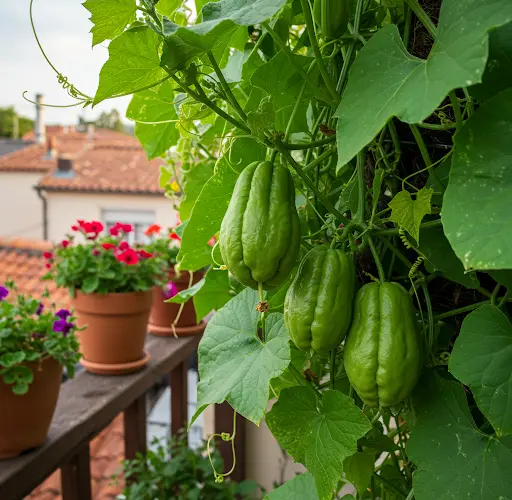Chayote, also known as vegetable pear or mirliton, is a unique and versatile vegetable that can be easily grown in plastic containers. It is a member of the gourd family, producing fruits that are delicious and nutritious. Although chayote is typically grown in the ground, it thrives just as well in containers, making it an excellent option for urban gardens, patios, balconies, and small spaces.
One of the best things about growing chayote is that it requires minimal care while producing a generous harvest. This article will walk you through some simple tips and techniques for growing chayote in plastic containers, allowing you to enjoy an abundant crop with little effort.
Why Grow Chayote in Containers?
Growing chayote in plastic containers offers numerous advantages, especially if you’re working with limited space. Here are a few reasons why this method is beneficial:
-
Space-saving: Chayote vines can be sprawling, so container gardening allows you to manage the space more efficiently.
-
Mobility: You can move the containers to different areas to maximize sunlight or protect the plant from harsh weather conditions.
-
No soil contamination: Growing in containers reduces the risk of pests and diseases typically found in the ground.
-
Easy maintenance: Chayote in containers are easy to water, fertilize, and monitor for growth.
Selecting the Right Container
When it comes to growing chayote, choosing the right container is crucial for success. Chayote vines have deep root systems and require plenty of space to spread. Here’s what to consider:
-
Size: Opt for large plastic containers, at least 18–24 inches deep and 24 inches wide. Chayote’s root system needs room to expand, so the larger the container, the better.
-
Drainage: Ensure the container has good drainage holes. Chayote needs well-draining soil to prevent waterlogging, which can lead to root rot.
-
Material: Plastic containers are ideal because they retain moisture better than terracotta or ceramic pots, making watering easier. They are also lighter and more durable, especially for outdoor use.
Preparing the Soil
Chayote thrives in well-draining, rich soil that is high in organic matter. For the best results, use a loamy mix combined with compost to provide the necessary nutrients. Here’s a simple mix to try:
-
50% potting soil
-
30% compost or well-rotted manure
-
20% perlite or sand for drainage
Fill the container with the prepared soil, leaving a few inches of space at the top to allow for watering.
Planting Chayote
Chayote is typically propagated by using the fruit itself, which has a unique method of sprouting. To plant chayote in a container:
-
Select a healthy chayote: Choose a firm, blemish-free fruit from a grocery store or nursery.
-
Plant the fruit: Place the entire chayote in the soil horizontally, with the pointed end facing up. The fruit should be buried about 1–2 inches deep in the soil. If you’re using a sprouted chayote, make sure the sprout is pointing upward.
-
Water well: After planting, water the container thoroughly. Keep the soil moist but not waterlogged during the germination period.
-
Wait for sprouting: Chayote takes 2–3 weeks to sprout. Once the plant begins to grow, you’ll see a vine emerging from the fruit.
Providing Support for the Vines
Chayote plants are vining climbers, which means they will need some sort of support to grow properly. Even in containers, you should provide a trellis, fence, or bamboo stakes for the vines to climb. This not only saves space but also helps keep the plant healthy by allowing proper airflow around the leaves and fruit.
-
Install a trellis or vertical structure soon after planting to guide the vines upward.
-
The vines can grow up to 10–15 feet in length, so make sure your support structure is tall enough to accommodate the plant’s growth.
-
As the vines grow, use soft ties or twine to help guide them along the support without damaging the plant.
Minimal Care and Maintenance
Once your chayote vines have established themselves, the care required is minimal. Here are the essential maintenance tips:
-
Watering: Keep the soil consistently moist, especially during the growing season. Water deeply, but ensure the container has proper drainage to prevent root rot.
-
Fertilizing: Chayote benefits from occasional feeding. Use a balanced liquid fertilizer or organic compost every 4–6 weeks. This will encourage strong vine growth and fruit production.
-
Pruning: Regular pruning helps manage the plant’s size and improves airflow. Trim any excessive growth, focusing on removing dead or unhealthy vines.
-
Pest control: Chayote is relatively pest-resistant, but keep an eye out for aphids or spider mites. If you notice any pests, use an organic insecticidal soap or neem oil spray.
Harvesting Chayote
Chayote fruits are typically ready to harvest around 6–9 months after planting. The fruits will be large, firm, and have a light green color. To harvest:
-
Check for maturity: The fruit should be about 6–8 inches long, firm, and free of blemishes.
-
Cut carefully: Use a sharp knife or pruning shears to cut the fruit from the vine, leaving a small stem attached.
-
Store the fruit: Chayote can be stored in a cool, dry place for several weeks before use.
Final Thoughts
Growing chayote in plastic containers is a simple and rewarding way to produce abundant, fresh fruits with minimal effort. By following these tips — choosing the right container, providing proper support, and offering just a little care — you can grow chayote successfully in even the smallest spaces. Not only does it produce delicious, versatile fruit, but it also adds a touch of greenery to your home garden.
If you’re looking for an easy-to-grow vegetable that doesn’t require a lot of attention, chayote is a perfect choice. Give it a try and enjoy the satisfaction of growing your own fruit in containers!



